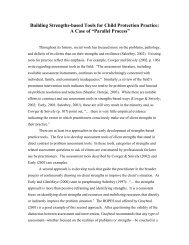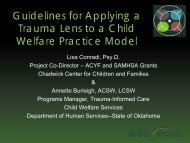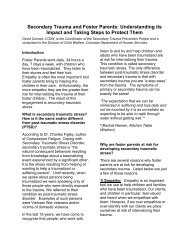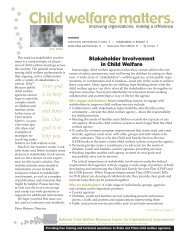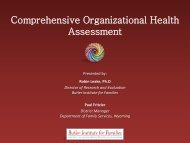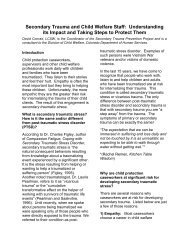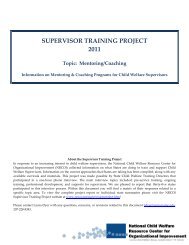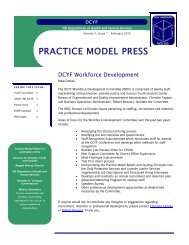Building a Model and Framework for Child Welfare Supervision
Building a Model and Framework for Child Welfare Supervision
Building a Model and Framework for Child Welfare Supervision
You also want an ePaper? Increase the reach of your titles
YUMPU automatically turns print PDFs into web optimized ePapers that Google loves.
Table of Contents<br />
Executive Summary 1<br />
Introduction 3<br />
Section I: Elements of an Emerging <strong>Model</strong> <strong>for</strong> <strong>Child</strong> <strong>Welfare</strong> <strong>Supervision</strong> 6<br />
1. Articulate in writing the organization's practice philosophy <strong>and</strong> approach 9<br />
2. Identify the functions <strong>and</strong> specific job responsibilities of child welfare supervisors 10<br />
3. Recognize the centrality of building <strong>and</strong> maintaining relationships with supervisees 19<br />
<strong>and</strong> others to carrying out supervisory responsibilities effectively<br />
4. M<strong>and</strong>ate explicit, manageable st<strong>and</strong>ards <strong>for</strong> caseload size <strong>and</strong> <strong>for</strong> supervisor- 20<br />
supervisee ratios<br />
5. Define expectations with regard to the frequency <strong>and</strong> <strong>for</strong>mat <strong>for</strong> supervision of 20<br />
frontline practitioners<br />
6. Clarify expectations <strong>for</strong> ongoing evaluation of frontline practitioners 21<br />
7. Support supervisors in their roles as unit leaders <strong>and</strong> change agents 22<br />
Section II: Components of an Organizational <strong>Framework</strong> that Supports Effective 23<br />
<strong>Supervision</strong> in <strong>Child</strong> <strong>Welfare</strong><br />
1. An organizational culture that values <strong>and</strong> demonstrates support <strong>for</strong> the vital role 24<br />
supervisors play in ensuring positive outcomes <strong>for</strong> children, youth <strong>and</strong> families<br />
2. A model of supervisory practice that reflects how the organization views the roles, 30<br />
responsibilities, <strong>and</strong> expectations of supervisors <strong>and</strong> includes up-to-date, written job<br />
descriptions<br />
3. Recruitment <strong>and</strong> retention of individuals who are a "good fit" as frontline 31<br />
practitioners <strong>and</strong> supervisors<br />
4. A continuum of professional development opportunities <strong>for</strong> new <strong>and</strong> experienced 33<br />
supervisors that includes initial <strong>and</strong> ongoing training, peer support, mentors,<br />
<strong>and</strong> clinical consultation<br />
Sources Cited 40<br />
Section III: Appendices<br />
Appendix A. Methodology 45<br />
Appendix B. Literature Review 48<br />
Appendix C. Interview Protocols 67<br />
Appendix D. Sample Job Description 84<br />
iii




